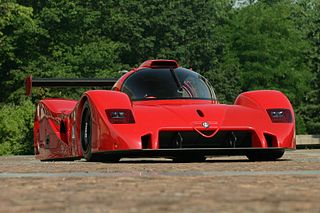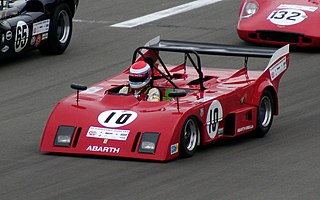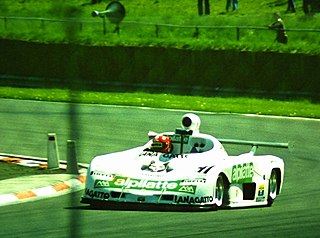
Abarth & C. S.p.A. is an Italian racing- and road-car maker and performance division founded by Italo-Austrian Carlo Abarth in 1949. Abarth & C. S.p.A. is owned by Stellantis through its Italian subsidiary. Its logo is a shield with a stylized scorpion on a yellow and red background.

The Alta Car and Engineering Company was a British sports and racing car manufacturer, commonly known simply as Alta. Their cars contested five FIA World Championship races between 1950 and 1952, as well as Grand Prix events prior to this. They also supplied engines to a small number of other constructors, most notably the Connaught and HWM teams.
Osella is an Italian racing car manufacturer and former Formula One team. They participated in 132 Grands Prix between 1980 and 1990. They achieved two points finishes and scored five world championship points.

The Fiat 124 Sport Spider is a convertible sports car marketed by Fiat for model years 1966–1985. Designed by and manufactured at the Italian carrozzeria Pininfarina factory, the monocoque, front-engined, rear-drive Sport Spider debuted at the November 1966 Turin Auto Show with styling by Tom Tjaarda.

The Lancia LC2 was a series of racing cars built by Italian automobile manufacturer Lancia and powered by engines built by their sister company Ferrari. They were part of Lancia's official factory-backed effort in the World Sportscar Championship from 1983 to 1986, although they continued to be used by privateer teams until 1991. They were also the company's first car meeting the FIA's new Group C regulations for sports prototypes.
The European Sportscar Championship was a name used by several sports car racing championships based in Europe. Initially created in 1970 by the Fédération Internationale du Sport Automobile (FISA) as the European 2-Litre Sports Car Championship for Makes, the series increased in popularity and eventually became part of the World Sports Car Championship in 1976 even after a troubled 1975 season. Only two years later, as interest in sports-prototypes faded, the championship was downgraded from World Championship status and a European championship returned once more, only to be cancelled after its sole 1978 season.

The Fiat-Abarth 750 is a compact sporting series of automobiles manufactured by the Italian manufacturing firm Abarth & C. of Turin, Italy in the 1950s and 1960s. The cars used the floorpan and often the bodywork of the Fiat 600 but were fitted with Abarth's modified engines. Abarth also offered a number of bodyworks by other designers for the 750 and its derivatives, most famously Zagato but also Allemano and others.

The Alfa Romeo SE 048SP was a Group C racing car built by Alfa Romeo in the early 1990s. Designed to replace the Lancia LC2 after the Group C regulations had undergone a major revamp, the SE 048SP had an Abarth-developed chassis mated to the 3.5-litre V10 engine from the stillborn Alfa Romeo 164 Procar, but, although at least one SE 048SP was built, it never left the development phase. The V10 engine appears to have been replaced by a Ferrari-sourced 3.5-litre V12 engine at some point during its development, although this was never officially confirmed by Alfa Romeo.

Vincenzo "Enzo" Osella is an Italian former racing driver and team owner. He is the founder and chairman of Italian auto manufacturer Osella. The team competed in Formula One between 1980 and 1990.

Nicola Materazzi was an Italian mechanical engineer who developed several sports and racing cars, including the Ferrari 288 GTO, Ferrari F40, Bugatti EB110, and B Engineering Edonis. He was one of Italy's leading turbocharging specialists from the mid-1970s, a respected sports car and motorcycle engineer, and is sometimes referred to as "Mr. F40" or the "father of the F40."

Abarth 2000 Sport (SE010) is an rear-engined racing car built by Italian car maker Abarth, which won its class at the 1000 km of Monza in 1971 and finished 11th overall. It was homologated for FIA Group 4 on 1 April 1969 with homologation number 252, and participated in a number of car races from 1969 to 1973. At least 50 cars were constructed, including the Sport SE mid-engine variant (SE014/019).

The Abarth 3000 Sport Prototipo was a sports car prototype made by Abarth & C. in Turin, Italy. It was the first Abarth with an engine with a capacity of more than 2-liters, after an already finished 6-liter twelve-cylinder from 1967 had become useless before it could be used due to a change in the regulations. The displacement for sports car prototypes was limited to 3 liters and for sports cars to 5 liters.

The Abarth-Osella PA1 is a 2-liter Group 5 prototype racing car built by Osella in collaboration with Abarth, to compete in the World Sportscar Championship sports car racing series in 1973, but was used in active competition through 1982.
The Osella PA2 is a 2-liter Group 5 prototype racing car built by Osella, to compete in the World Sportscar Championship sports car racing series from 1974 to 1975, but was used in active competition IMSA GT Championship until the end of 1985. It was initially powered by either the 2.0 L (120 cu in) Abarth twin-cam engine, or later, the BMW M12/7 Turbo engine. It scored a total of 3 wins, and 6 podiums. The type was entered 63 times.

The Osella PA3 is a Group 6 prototype racing car designed, developed, and built by Osella, to compete in the World Sportscar Championship sports car racing series in 1975, but was used in active competition through 1986. It was powered by a number of different engines, including the 2.0 L (120 cu in) BMW M12/7, the Abarth twin-cam engine, and the Cosworth BDG, or the 1.3 L (79 cu in) Cosworth BDH, or even the smaller 998 cc (60.9 cu in) Cosworth SCA. The 1.6 L (98 cu in) and 1.8 L (110 cu in) Cosworth FVA and Cosworth FVC were also used. It was even powered by a Ferrari 2.0 V8 engine. It scored a total of 13 wins, and 25 podiums. It was entered 103 times during its career.

The Osella PA6 and Osella PA7 are Group 6 prototype racing car designed, developed, and built by Osella, to compete in the World Sportscar Championship sports car racing series between 1978 and 1982. It was powered by a number of different engines, including the 2.0 L (120 cu in) BMW M12/7 and the Cosworth BDG, and the 1.6 L (98 cu in) Cosworth FVA was also used. After retiring from sports car racing, these cars later competed in hillclimb racing.

The Osella PA8 was a 2-liter, Group 6, sports car prototype, developed by Osella Squadra Corse in 1980, and used in sports car and Hillclimb races until 1988. It is powered by the naturally aspirated, 300 hp (220 kW), 2.0 L (120 cu in) BMW M12/7 engine, drives the rear wheels via a 5-speed Hewland LGA manual transmission.

The Osella PA9 was a 2-liter, Group 6, sports car prototype, developed in 1981 by the Turin racing car manufacturer Osella and used by the factory in sports car and hill climb races until 1988.

The Ferrari 712P is a purpose-built Group 7 prototype, designed, developed and built by Scuderia Ferrari specifically designed to compete in Can-Am sports car races from 1970 to 1974. The 7 refers to the displacement of the engine in liters, the 12 refers to the number of cylinders, and the P stands for Prototype.
The Fiat Abarth OTR 1000, alternatively known as Fiat Abarth 1000 OTR, is a sport subcompact model automobile produced by the Italian automobile manufacturer Abarth. With its special "Radiale" engine, it was built between 1964 and 1969 in various versions in very small numbers based on the Fiat 850.



















